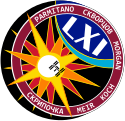Jessica Meir
| Jessica Meir | |
|---|---|
 Jessica Meir v září 2018 | |
| Astronaut NASA | |
| Státní příslušnost | |
| Stav | aktivní |
| Datum narození | 15. července 1977 (47 let) |
| Místo narození | Caribou |
| Jiné zaměstnání | astronautka, fyzioložka |
| Čas ve vesmíru | 204 dní, 15 hodin a 19 minut |
| Mise | Expedice 61/62 (Sojuz MS-15/ISS) |
| Znaky misí | |
| Některá data mohou pocházet z datové položky. | |
Jessica Ulrika Meir (* 1. července 1977) je americká astronautka NASA, mořská bioložka a fyzioložka. Dříve působila jako odborná asistentka anestezie na Harvardově univerzitě[1] a po disertaci jako výzkumnice v oblasti komparativní fyziologie na Univerzitě Britské Kolumbie. Studovala fyziologii potápění a chování tučňáků císařských na Antarktidě[2] a fyziologii hus indických a jejich schopnosti přeletu Himálaje.[3] V září 2002 Meir sloužila jako aquanautka v rámci mise NASA NEEMO 4. V roce 2013 byla vybrána do užšího výběru potencionálních astronautů. 25. září 2019 odstartovala v kosmické lodi Sojuz MS-15 na Mezinárodní vesmírnou stanici, kde v rámci expedic 61 a 62 sloužila jako palubní inženýrka. 18. října 2019 spolu s Christinou Koch podnikla první čistě ženský výstup do vesmíru.
Reference
V tomto článku byl použit překlad textu z článku Jessica Meir na anglické Wikipedii.
- ↑ Jessica U. Meir [online]. 2015-03-10, rev. 2017-08-07 [cit. 2020-02-07]. Dostupné v archivu pořízeném dne 2019-03-23. (anglicky)
- ↑ Penguins continue diving long after muscles run out of oxygen. ScienceDaily [online]. 2011-05-16 [cit. 2020-02-07]. Dostupné online. (anglicky)
- ↑ ARNOLD, Carrie. Sky's No Limit in High-Flying Goose Chase. U.S.News [online]. 2011-04-15 [cit. 2020-02-07]. Dostupné online. (anglicky)
Externí odkazy
 Obrázky, zvuky či videa k tématu Jessica Meir na Wikimedia Commons
Obrázky, zvuky či videa k tématu Jessica Meir na Wikimedia Commons
Média použitá na této stránce
The official insignia of the Expedition 62 crew
- The Expedition 62 patch embodies two main themes: first, the importance of the global partnership on which the International Space Station was founded, and second, the paradigm shifting perspective provided by seeing our planet Earth from above with human eyes. Based on a vintage mosaic found near the headquarters of the Gagarin Cosmonaut Training Center, the two space explorers flying in formation represent friendship between space agencies and the people that work in them. The shining star in the hand is a symbol of unity under a common quest for discovery, as this partnership continues to burn bright into the future.
- Generated by the flying astronauts, the shock wave signifies the powerful impact of human space exploration and the scientific research conducted on the space station, strengthened when we work as a team, side by side with all of our international partners. The backdrop of the large sun behind our planet Earth reminds us that we are but a very small component of our solar system and our universe. The sun is also responsible for fueling life on Earth, sustaining the biosphere (symbolized by the leaf) surrounded by the precious, fragile atmosphere (represented by the clouds).
- This imagery reminds us of our duty to protect our home planet, to preserve our environment and to carry principles of responsible environmental stewardship with us as we explore the universe. This birch leaf combines the principal elements, embodying nature, science and the global alliance, as these trees are indigenous to regions that crewmembers from all sides call home.
The mission insignia for the Expedition 61 crew with Commander Luca Parmitano of ESA (European Space Agency), NASA astronauts Drew Morgan, Christina Koch and Jessica Meir and Roscosmos cosmonauts Alexander Skvortsov and Oleg Skripochka.
- The Expedition 61 patch represents an exciting and dynamic time aboard the International Space Station as it constantly advances towards a limitless future in space. The overall patch view is from an approaching vehicle in pursuit of the space station. The sun is the most prominent, central element in the patch as the source of energy and life for the Earth, the station and our entire solar system. As the present focus of human spaceflight, the space station is centered in the emblem while barely eclipsing the sun with its tiny shadow, reminding of us that human exploration is a small part of our quest to understand the universe.
- Fifteen of the sun’s rays represent the 15 original partner members of the space station program, while the 16th ray represents an open invitation for continued collaboration with new partners. The four yellow rays form the cardinal directions of a compass, symbolizing the innate human drive to explore. The advancing terminator represents the dawn of a new day on Earth. The name ring appears to float through space and has no single orientation, emphasizing the variety of viewpoints assembled in an international crew unified under one mission. Nine rays extend beyond the name ring to represent the nine human missions that have braved exploration beyond low-Earth orbit, thus encouraging us to drive boundlessly out into our solar system.
Portrait of NASA Astronaut Jessica Meir in an Extravehicular Mobility Unit (spacesuit).



